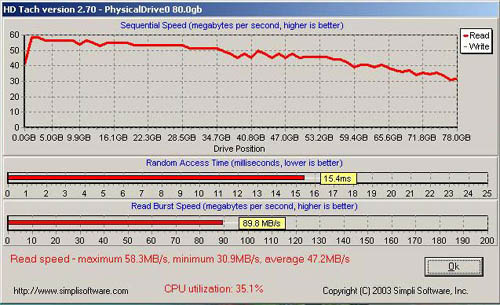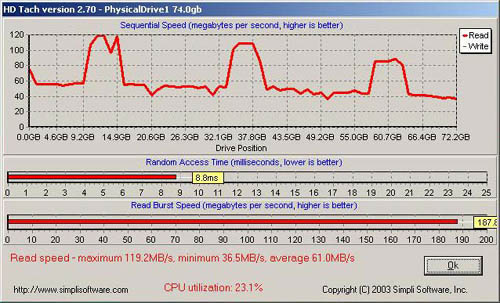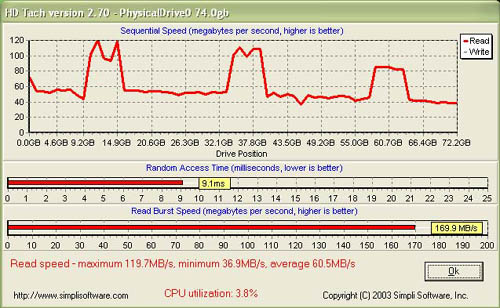nForce3-250 - Part 2: Taking Athlon 64 to the Next Level
by Wesley Fink on March 29, 2004 11:00 AM EST- Posted in
- CPUs
nForce3-250Gb: IDE and RAID Benchmarks
Disk Performance Testing can provide extremely variable results, even when test conditions are well-controlled. For that reason, we were skeptical to drop IDE and RAID tests into our review of the nForce3-250Gb. However, it was certain, given nVidia's past lackluster drive performance, that HD tests should be included in nF3-250 benchmarking.Some of the most commonly used benchmarks for Hard Drive Testing are HDtach 2.7, PCMark 2004 HD Tests and SiSoft Sandra 2004 File System Benchmark. We have included all 3 test results here for both IDE and nVidia RAID. Tests in both cases were run on Hard Drives about 20% full, with the benchmark run from the IDE hard drive. The IDE hard drive was a 7200 RPM 80GB drive with a 50GB C: boot partition, and tests were run on C:. The RAID array was 2 Western Digital Raptor 10,000 RPM 36.7GB hard drives. Both the IDE and RAID were driven by nVidia IDE drivers in nForce Platform Driver 4.04.
Sandra 2004 shows a 38% increase in throughput with nVidia 10,000RPM RAID compared to a single 10,000RPM SATA drive. PCMark 2004 HDD Test Suite shows a smaller increase in performance with RAID, around 27%. Benchmarks for a single 7200RPM IDE are also included for comparison.
Perhaps even more important for critics of past nVidia IDE implementations is that nVidia and Intel throughput in IDE is now about the same with the nForce3-250Gb. Intel SATA RAID is a bit faster in Sandra, but the difference in measured benchmark performance was very small, at about 6%.
For those who hate the numbers from benchmarks like Sandra and PCMark, the HDTach screen captures provide a very interesting snapshot. The two graphs below, with blue title bars, represent nVidia's nForce3-250Gb drive controller performance.


We also tested the Intel RAID controller with another pair of 10,000 rpm Western Digital Raptors. Those results are shown with the green title bar below.

As you can see, performance of the Intel SATA RAID and nVidia SATA RAID are virtually identical.
The biggest surprise in the HD Tach benchmarks was the fact that SATA RAID requires half the overhead of basic IDE in nVidia's implementation. However, the CPU utilization, while greatly improved over numbers we have seen for nVidia in the past, is still very high compared to Intel's SATA RAID. Part of this has to do with the architectural differences between Athlon 64 and Intel processors and chipsets, but there is still a large difference in CPU overhead between the nVidia and Intel RAID solutions. Frankly, the real performance difference is likely to be nil on the typical desktop, but this will matter to some.










46 Comments
View All Comments
TrogdorJW - Monday, March 29, 2004 - link
And for amalinov, lay off the caffeine/Bawls/whatever for a while and take a few chill pills. THG and AT got you down for not spending three pages clearly spelling out every nuance of Hypertransport in every single article that mentions them? OMG, how ever will we survive? If it's that important to you, maybe you should include the correct information rather than just ranting about the problem. For the record:In AMD Athlon 64/Opteron systems, the Hypertransport bus is clocked at 800 MHz and is double-pumped, yielding a theoretical rate of 1.6 GHz. However, that is both upstream and downstream rates, so if you want to get a bigger number you can call it 3.2 GHz full duplex speed. Normally, the Hypertransport bus is 16-bits wide, which would then give you 51.2 Gbps of bandwidth. Using marketing, you divide that by 8 and come up with 6.4 GBps of bandwidth.
Now, of course, is a great time to get your pants in a bind about the lack of proper conversion between GHz and GBps. 1 GHz is 1 billion cycles per second, of course, while 1 GB is 1024*1024*1024 bytes. So in reality, the 6.4 GBps speed is inflated, and the real value is 5.96 GBps. But that requires more math skill and technical knowledge than most people possess, and so it's easier to just "fudge" the result. Intel, of course, has the same problem with their 800 FSB providing 6.4 GBps of bandwidth. Notice how in benchmarks, none of the current chipsets for any platform ever surpass 6 GBps of bandwidth? That's because they *can't*. Realistically, anything in the neighborhood of 5.5 GBps or so is "maxed out".
Then of course we have the problem with the original Nforce3 150 only providing 800 MHz and 16-bit upstream with 600 MHz and 8-bit downstream (or vice versa if you prefer - me, I call going from RAM to CPU "up" and CPU to RAM "down", but others, like THG, differ). So on the Nforce3 150, your maximum upstream bandwidth (i.e. from the RAM to the CPU) was 3.2 GBps (really only 2.98 GBps because of the 1 GB = 1,000,000,000 "fudge"). Your downstream bandwidth (i.e. from the CPU to RAM) was only 1.2 GBps (once again, only 1.11 GBps really), with the total aggregate memory bandwidth being 4.4 GBps (4.09 GBps true speed).
There. Do you feel better now? Is everyone enlightened? Probably not. Adding such a lengthy explanation to every fraggin' article that discusses chipsets would just be redundant bloat. Those who really care probably already know, and those who don't care will just get tired of hearing about it. You might as well dredge out the old hard drive manufacturer claim where 1,000,000 bytes = 1 MB and 1,000,000,000 bytes = 1 GB. But hey! There's a class action lawsuit on that already, so maybe we can get something done about Hypertransport and FSB bandwidth claims as well?
TrogdorJW - Monday, March 29, 2004 - link
Wow... lot's of hate in the comments today!Overall, the major change with NF250 seems to be the working PCI/AGP lock, plus some features that were often included via other chips on the high-end boards. I do like Nvidia's answer to Intel's CSA, even though I'm still running 100 Mbit. Maybe in the near future I'll upgrade to a GbE switch, but for now I only have one PC with a GbE port, so it's pointless. I'm a little surprised at the RAID CPU usage... almost looks like software RAID to me! 25%-35% CPU usage is way higher than I would consider acceptable!
Anyway, here's my one big complaint: You show how NF250 + FX5950U was in general faster than NF250 + R9800XT. Big whoop. Since the only other comparison that isn't NF250-based is running on the SiS chipset with a 9800XT, we don't know whether the performance boost is due solely to the graphics card, solely to the chipset, or a combination of both. It's most likely a combination, but it would have been much better to include the FX5950U on the SiS motherboard as well. We have the baseline measurement for the 9800XT, but we don't have a baseline measurement for the FX5950U.
notoriousformula - Monday, March 29, 2004 - link
Stupid Anandtech Flash graphs, can't even copy and paste on word :-(..Overall Great review!
PS: i don't have internet at home, i was trying to save the article to floppy disk.
PrinceGaz - Monday, March 29, 2004 - link
A little more investigation into the slight performance-increase nVidia cards gain on an nVidia mobo (or possibly a deliberate penalty non-nVidia cards receive?) would be interesting.I trust that no graphics-card reviews will even consider using nVidia chipset mobos (or other major gfx-card manufacturer) as the testing platform now it looks like they give their own cards an advantage, even if they offer the best performance overall on any card. It would be better to use a lower-performing platform than a biased one.
Phiro - Monday, March 29, 2004 - link
In ALL comparisons? You mean the ONE comparison, the mysterious 67 versus the INTEL 13 versus the NVIDIA 6, locked in a titanic struggle over the fate of the world's supply of Crayola magic markers! Who will win, and what doom awaits the survivors on Earth?Wait until the next exciting episode of AnandTech Z, where we'll spend 30 minutes of your time showing you 3 minutes of data!
Wesley Fink - Monday, March 29, 2004 - link
#28 -It was an INTEL PCI Gigabit Ethernet adapter in all comparisons to PCI Ethernet.
#26 and #27 -
I will add 10,000 rpm single drive benchmarks to the Sandra and PCMark2004 charts. As soon as the benchmarks are complete the charts on page 2 will be updated.
amalinov - Monday, March 29, 2004 - link
regarding Wesley Fink's #22:I understand the point about SiS755/FX, nf3-250Gb/Ultra, K8T800/Pro. If the difference between these models is "the smaller chipset supports max HT@1.6GHz, the bigger - HT@2GHz" (here I intentiosly use data frequency of HT, and not clock frequency - witch is half: 800MHz and 1GHz. This is becouse elsewere - for FSBs, and for Memory speeds all we use data frequency "800MHz P4 bus", "1000MHz GeforceFX memory", "550MHz DDR SDRAM").
BUT if you add to this REAL difference the imaginary "smaller chipset supports S754, bigger supports S939" - this IS WRONG!!!
but that is not my point. Here it is:
in the article was written:
", on the dual-channel nForce3-250Gb Ultra version of this chipset."
I want to emphasis that THERE IS NO and WILL BE NO "dual channel CHIPSET version" for A64, S754, S939, S940 or whatever. If Nvidia wants to make us to believe "buy newer and more costly nf3-250 ULTRA boards for S939" this does not mean that we (and mobo makers) should believe them and not use S939 CPUs with non-Ultra nf3s. HT2GHz will not bring any performance benefits anyway (it will be advantage to chipsets with integrated video. It will be advantage to 2-way, 4-way, 8-way Opteron systems. It will be advantage to chipsets with multiple PCI Express x16 and/or chipset with 8-drive RAID-array with SATA/300. But for normal use HT@2GHz will bring nothing over current HT@1.6GHz).
regarding #29:
I don't want to flame. I THINK that I make only a "constructive criticism". Before I have sended some emails to a motherboard reviewer at AnandTech and later (after 1-2-3 reviews) they taked into account my remarks and changed the wrong sounding of a minor thing (about the space between the AGP and DIMMs). So I can only congratulate them! Here again Wesley Fink answers my "flames" and I am gratefull. I also so hope that the quality of writing will improve becouse of such critic/flames.
Ilmater - Monday, March 29, 2004 - link
"Also, another topic not well understood at Anandtech, Tom's, etc.: A64/Opteron FSB speed, HyperTransport speed, etc. - they (the writers) are mixing up clock frequency in MHz, data frequency in DDR and MHz, bandwith in GB/s. They think FSB and HyperTransport is the same thing. They think that HyperTransport is 800MHz (or maybe 200MHz "quadrupelt") - maybe becouse of similarity with P4. They think that their nf3-250Gb has a "250MHz FSB". They don't explain to the users on what depends the memory clock in a A64 system."Easy trigger. amalinov, I think you're jumping the gun here a bit. What TRULY makes or breaks a review, IMHO, is the conclusions drawn from the given data and the suite of tests performed. You people are psychotic, and I feel bad for those at AT. CALM DOWN!
First off, 90% of all online hardware review sites mix up the bus rate, the data throughput, and the bandwidth. Yes, they should establish a standard, but to come in here flaming about it is ridiculous. Voice your opinions calmly on a board and I'm sure they'll address them. I'm very impressed with their response to criticism here. If you find that they don't address your concerns, then post in the forums and concensus about it. That's a much better means to an end.
Secondly, the reason I left Tom's was because they seemed to grab RIDICULOUS conclusions from given data. There would be two benchmarks right next to each other and they'd claim statistical insignificance, but then there would be another with less of a difference and they'd claim that one was STOMPING the other. They seemed to favor certain manufacturers.
However, I do not feel that AT falls victim to that.
So, amalinov, while I feel that some of your criticisms are valid, I feel that you should voice them differently and ease off the flames.
Now I get to voice my opinion, and I agree with jeremyk442 in #26, and I feel these were glaring omissions. IMO, those SATA/RAID benchmarks are mostly worthless. Just some (hopefully) helpful criticism, I think you should think about what you really want the benchmarks to show before you run them. While it's nice as a side note to show people looking to possibly upgrade to a RAID array how two WD Raptor 10k drives (a very likely upgrade choice) in RAID 0 compare to a single 7200 RPM drive (a common starting point for those looking to upgrade), that's a different article. These benches should be to show the benefit of this RAID array vs. others, or at least a single drive (drive x) vs. two of the same drives (two drive x's).
For the most part, I thought it was a pretty good article and very interesting, but there were some glaring problems.
Phiro - Monday, March 29, 2004 - link
Wesley Fink:"We showed some benchmarks of Gigabit LAN in Part 1, Page 6 of the nForce3-250 review."
You call those benchmarks? #1, it ain't plural. You put one crummy graph up. #2, a first grader would be ashamed of a bar graph like that. What is it a benchmark of, how long it took you to color it in with your Crayola marker? 67 to 13 to 6? Of what? To what? Doing what? "PCI Gigabit Ethernet" - what brand? It's no brand - all that is, is a drawing of THEORETICAL speeds!
"We also discussed throughput benchmarks in Part 1 of the article and in front page comments in reply to questions. "
Geez, I'm sorry, I didn't wade through 70 comments looking for it. Also, I apologize for thinking that part 2 of your review, you know, the part you said "will contain benchmarks", might actually.. contain a benchmark!
"We chose NOT to publish these benchmarks in a splashier way because you will actually see the doubling of performance only in somewhat rare situations on today's systems."
First off, you can quit thinking you know how we use our computers. You don't. Benchmark the shit, take our feedback, improve your process, rinse, repeat. With a fat banner ad or two around the frame, you make your money. The moment you start thinking for us = the wrong moment.
"You will not, for instance, see any difference today in broad-band network connections available to most users."
Just post the goddamned numbers flyboy, and read your editorial to your dog, who gives a much bigger crap than the rest of us.
Look, I tried to ask nice - I even said "jeebus" up there instead of worse word. But all you want to do is make excuses and explain how it's not really your fault.
It's really your fault.
Nighteye2 - Monday, March 29, 2004 - link
Why is the RAID comparison against an Intel solution? That's throws in too many variables...The ASUS K8V also has SATA RAID, so why not compare it to that? That'll also be more useful for people looking to buy an Athlon 64 system...